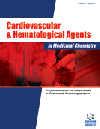- Home
- A-Z Publications
- Cardiovascular & Hematological Agents in Medicinal Chemistry (Formerly Current Medicinal Chemistry - Cardiovascular & Hematological Agents)
- Previous Issues
- Volume 17, Issue 1, 2019
Cardiovascular & Hematological Agents in Medicinal Chemistry (Formerly Current Medicinal Chemistry - Cardiovascular & Hematological Agents) - Volume 17, Issue 1, 2019
Volume 17, Issue 1, 2019
-
-
Fluoroquinolones and the Risk of Aortic Aneurysm or Aortic Dissection: A Systematic Review and Meta-Analysis
More LessAuthors: Prashanth Rawla, Marie L. El Helou and Anantha R. VellipuramObjectives: We performed a systematic review and meta-analysis to explore the risk of an aortic aneurysm or aortic dissection following fluoroquinolone administration. Methods: PubMed, Cochrane library, ClinicalTrials.gov, Embase and Google Scholar were systematically reviewed for controlled studies including adult patients exposed to fluoroquinolones with a primary outcome of aortic aneurysm or aortic dissectio Read More
-
-
-
Artificial Blood: A Futuristic Dimension of Modern Day Transfusion Sciences
More LessAuthors: Rudrashish Haldar, Devendra Gupta, Shweta Chitranshi, Manish K. Singh and Sumit SachanArtificial blood is an innovative concept of transfusion medicine where specifically designed compounds perform the task of transport and delivery of oxygen in the body to replace this function of allogenic human blood transfusion. Several molecules have been developed in the past few decades to achieve this objective and continous refinements are being continuously made in the quest of the ideal blood substitute. Curr Read More
-
-
-
The Cardiovascular Protective Effects of Chrysin: A Narrative Review on Experimental Researches
More LessAuthors: Tahereh Farkhondeh, Saeed Samarghandian and Fereshteh BafandehChrysin is one of the flavonoids fruits, vegetables, and plant especially found in honey, it has been indicated that its cardiovascular protective effect is due to its antioxidative effects and antiinflammatory activities. Chrysin exerts an antioxidant effect by enhancing the antioxidant system, suppressing pro-oxidant enzymes, scavenging free radicals and chelating redox active transitionmetal ions. Chrysin decreases lipid synt Read More
-
-
-
Flavonoid-Enriched Extract from Desert Plant Warionia saharae Improves Glucose and Cholesterol Levels in Diabetic Rats
More LessAuthors: Mohammed Ajebli and Mohamed EddouksBackground and Objective: Warionia saharae Benth and Coss, is a medicinal plant used for its anti-diabetic properties in Morocco. This study was designed to examine the effect of the Flavonoid- Enriched Extract (FEE) obtained from Warionia saharae (W. saharae) on glucose and lipid metabolism in normal and streptozotocin (STZ)-induced diabetic rats. Methods: Acute (6 h) and sub-chronic (15 days) oral administratio Read More
-
-
-
Radioprotective Effect of Gliclazide as an Anti-Hyperglycemic Agent Against Genotoxicity Induced by Ionizing Radiation on Human Lymphocytes
More LessAuthors: Maysa Pouri, Zahra Shaghaghi, Arash Ghasemi and Seyed J. HosseinimehrObjectives: Gliclazide (GL) is widely used to reduce hyperglycemia in diabetic patients. The aim of this study was to investigate the protective effect of GL against chromosome damage induced by ionizing radiation in human blood lymphocytes. Methods: In this experimental study, peripheral blood samples were collected from human volunteers and treated with GL at various concentrations (5, 25, 50 or 100 μM) for three hour Read More
-
-
-
Hypolipidemic and Antioxidant Activities of Corrigiola telephiifolia in Diabetic Rats
More LessAuthors: Morad Hebi and Mohamed EddouksObjective: The evaluation of the hypolipidemic and antioxidant activities of the aerial parts aqueous extract of Corrigiola telephiifolia (APAE of C. telephiifolia) in normal and streptozotocin (STZ)-induced diabetic rats. Methods: The effects of oral administration of APAE of C. telephiifolia (5 mg/kg) on the lipid profile as well as the in vitro antioxidant activity of this aqueous extract have been determined. Results: APAE of C. te Read More
-
-
-
Emblica officinalis (Amla) Ameliorates High-Fat Diet Induced Alteration of Cardiovascular Pathophysiology
More LessAuthors: Bheemshetty S. Patil, Pallavi S. Kanthe, Chandramouli R. Reddy and Kusal K. DasBackground: Dietary high fat possibly causes oxidative stress. Also, it alters the pathophysiology of metabolically active myocardial tissues and vascular architecture. Emblica officinalis contains a potential antioxidant that counteracts oxidative stress and possibly maintains vascular integrity. Objectives: To assess the effect of ethanolic extract of Emblica officinalis (EEO) on High Fat Diet (HFD) induced changes in vascular chem Read More
-
-
-
Leaf Aqueous Extract of Argania spiniosa Exhibits Antihyperglycemic Effect in Diabetic Rats
More LessAuthors: Morad Hebi and Mohamed EddouksIntroduction: Argania Spinosa L. (Sapotaceae) is an endemic species from south-western Morocco. This plant has many traditional uses including its use in the treatment of diabetes. Objective: The objective of the study was to evaluate the antidiabetic activity of Argania Spinosa Leaf Aqueous Extract (A.S.L.A.E). Methods: The antidiabetic effect of A.S.L.A.E was evaluated in both normal and streptozotocin (STZ)-induced diabetic Read More
-
Volumes & issues
-
Volume 23 (2025)
-
Volume 22 (2024)
-
Volume 21 (2023)
-
Volume 20 (2022)
-
Volume 19 (2021)
-
Volume 18 (2020)
-
Volume 2 (2020)
-
Volume 17 (2019)
-
Volume 16 (2018)
-
Volume 15 (2017)
-
Volume 14 (2016)
-
Volume 13 (2015)
-
Volume 12 (2014)
-
Volume 11 (2013)
-
Volume 10 (2012)
-
Volume 9 (2011)
-
Volume 8 (2010)
-
Volume 7 (2009)
-
Volume 6 (2008)
-
Volume 5 (2007)
-
Volume 4 (2006)
Most Read This Month
Article
content/journals/chamc
Journal
10
5
false
en


